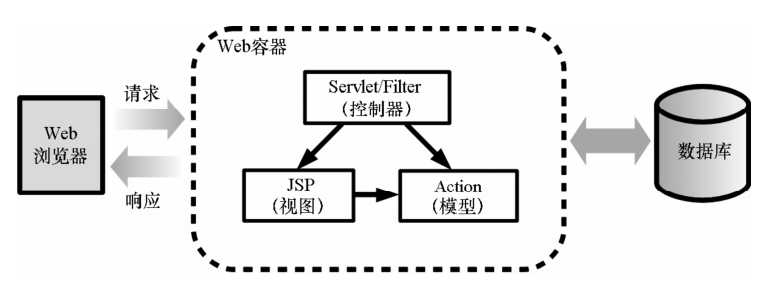标签:put ordinary 定制 inpu param 目标 control att static
MVC 代表 Model-View-Controller (模型-视图-控制器) 模式。
Java Web 应用开发中有两种设计模型,Model 1 和 Model 2。
Model 1 的中心是 JSP 页面,由 JSP 调用业务逻辑,显示页面,适合于小应用开发。
由 JSP 充当 视图和控制器,JavaBeans 充当模型。
Model 2 基于 MVC 模式,几乎所有现代 Web 框架都是 Model 2 的实现。
由 JSP 充当视图,Servlet 或 Filter 充当控制器,JavaBeans 充当模型。
每个HTTP 请求都发送给控制器,请求中的 URI 标识出对应的 action。action 代表了应用可以执行的一个操作。
控制器会解析 URI 并调用相应的 action,然后将模型对象放到视图可以访问的区域。
最后,控制器利用 RequestDispatcher 或者 HttpServletResponse.sendRedirect 方法跳转到视图。在 JSP 页面中,用表达式语言以及定制标签显示数据。
@WebServlet(name="ControllerServlet", urlPatterns={"/input-product", "/save-product"})
public class Controllerservlet extends HttpServlet{
private static final long serialVersionUID=1579L;
@Override
public void doGet(HttpServletRequest request, HttpServletResponse response throws IOException, ServletException {
process(request, response);
}
@Override
public void doPost(HttpServletRequest request, HttpServletResponse response) throws IOException, ServletException {
process(request, response);
}
// 通过 process 方法处理所有输入请求
private void process(HttpServletRequest request, HttpServletResponse response) throws IOException, ServletException{
// 获取 action
String uri = request.getRequestURI(); // uri = /contextName/resourceName 或 /resourceName
int lastIndex = uri.lastIndexOf("/");
String action = uri.substring(lastIndex +1);
// 转发 url
String dispatchUrl = null;
// 处理 action
if("input-product".equals(action)){
dispatchUrl = "/jsp/ProductForm.jsp";
} else if("save-product".equals(action)){
// 创建模型
product = new Product();
product.setName(request.getParameter("name"));
product.setDescription(request.getParameter("description"));
product.setPrice(Integer.parseInt(request.getParameter("price")));
// 业务逻辑 保存模型等
SaveProductAction saveProductAction = new SaveProductAction();
saveProductAction.save(product);
// 将模型添加到 request 属性中 以便视图访问
request.setAttribute("product", product);
dispatchUrl = "/jsp/ProductDetails.jsp";
}
// 转发
if(dispatchUrl != null){
RequestDispatcher rd = request.getRequestDispatcher(dispatchUrl);
rd.forward(request, response);
}
}
}
<%--ProductForm.jsp--%> <form method="post" action="save-product"> <h1>Add Product</h1> <label> <span>Product Name:</span> <input id="name" type="text" name="name"> </1abel> <label> <span>Description:</span> <input id="description" type="text" name="description"> </label> <label> <span>Price:</label> <input id="price" name="price" type="number" step="any"> </label> <label> <span> :</span> <input type="submit"> </label> </form>
@WebFilter(filterName="DispatcherFilter", urlPatterns={"/*"})
public class DispatcherFilter implements Filter{
@Override
public void init(Filterconfig filterconfig) throws ServletException { }
@Override
public void destroy() { }
@Override
public void doFilter(ServletRequest request, ServletResponse response, FilterChain filterChain) throws IOException, ServletException {
HttpServletRequest req = (HttpServletRequest) request;
String uri = req.getRequestURI();
// ... 与 Servlet Controller 一致
if (dispatchUrl! = null){
RequestDispatcher rd = request.getRequestDispatcher(dispatchUrl);
rd.forward(request, response);
} else {
// 过滤器过滤包括静态目标在内的所有网址 如果没有 action 则继续传递下去
filterChain.doFilter(request, response);
}
}
}
标签:put ordinary 定制 inpu param 目标 control att static
原文地址:https://www.cnblogs.com/JL916/p/11831094.html